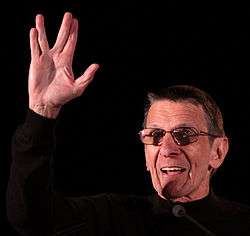Vulcan salute

The Vulcan salute is a hand gesture popularized by the 1960s television series Star Trek. It consists of a raised hand with the palm forward and the thumb extended, while the fingers are parted between the middle and ring finger.
Background
The Vulcan salute was devised by Leonard Nimoy, who portrayed the half-Vulcan character Mr. Spock on the original Star Trek television series. A 1968 New York Times interview described the salute or greeting gesture as a "double-fingered version of Churchill's victory sign". Nimoy said in that interview that he "decided that the Vulcans were a 'hand-oriented' people".[1]
The salute first appeared in 1967 on the Star Trek second season opening episode, "Amok Time". Among other things, the gesture is known for being difficult for certain people to do properly without practice or the covert pre-positioning of the fingers, and actors on the original show reportedly had to position their fingers off-screen with the other hand before raising their hand into frame. This difficulty may stem from variations in individuals' manual dexterity. Its reputation is parodied in the motion picture Star Trek: First Contact when Zefram Cochrane, upon meeting a Vulcan for the first time in human history, is unable to return the Vulcan salute gesture and instead shakes the Vulcan's hand.

In his autobiography I Am Not Spock, Nimoy wrote that he based it on the Priestly Blessing performed by Jewish Kohanim with both hands, thumb to thumb in this same position, representing the Hebrew letter Shin (ש), which has three upward strokes similar to the position of the thumb and fingers in the salute. The letter Shin here stands for El Shaddai, meaning "Almighty (God)", as well as for Shekinah and Shalom. Nimoy wrote that when he was a child, his grandfather took him to an Orthodox synagogue, where he saw the blessing performed and was impressed by it.[2]
Others often greeted Nimoy with the salute,[3] which became so well-known that in June 2014 it was added to version 7 of the Unicode standard as U+1F596 🖖 RAISED HAND WITH PART BETWEEN MIDDLE AND RING FINGERS.[4][5]
The White House referenced the salute in its statement on Leonard Nimoy's death, calling it "the universal sign for 'Live long and prosper'."[6] The following day, NASA astronaut Terry W. Virts posted a photo on his Twitter feed from the International Space Station showing the hand gesture (with the Earth in the background) as the ISS passed over Nimoy's birthplace of Boston, Massachusetts.[7]
Gallery
-

NASA astronaut Terry W. Virts performs the Vulcan salute in an homage to Leonard Nimoy from the International Space Station on February 27, 2015, shortly after hearing of Nimoy's passing; Nimoy's home town of Boston is seen directly below.
-

ESA astronaut Samantha Cristoforetti on Feb. 28, 2015 tweeted this photo in a final salute to Leonard Nimoy.
-

George Takei, a colleague of Nimoy who portrayed the Star Trek character Hikaru Sulu in the original series, salutes a crowd in 2011.
-

A cosplayer gives the Vulcan salute
"Live long and prosper"
The accompanying spoken blessing, "live long and prosper" – "dif-tor heh smusma" in the Vulcan language (as spoken in Star Trek: The Motion Picture) – also appeared for the first time in "Amok Time", scripted by Theodore Sturgeon.[8] The less-well-known reply is "peace and long life", though it is sometimes said first, with "live long and prosper" as the reply. In science fiction, the phrase 'live long' first appeared in print in 1957 in Eric Frank Russell's science fiction novel Wasp where it was used both as a greeting and as a farewell by a species of aliens called the Sirians. The phrase has been seen abbreviated "LLAP".[9][10][11]
This format is similar to common Middle Eastern greetings (Salaam alaykum in Arabic and Shalom aleichem in Hebrew), meaning "peace be upon you", and its reply, "upon you be peace". An ancient Egyptian blessing "ankh wedja seneb", while its verbatim translation is uncertain, uses the three symbols "life", "prosperity" and "health"; it has been translated as "may he live, be prosperous, be healthy."[12] The New International Version of the Bible, Deuteronomy 5:33, includes the phrase "live and prosper" as part of Moses' admonitions to the Hebrew people prior to entering Canaan; other translations include the notion of long life as well.[13] William Shakespeare's 1594 Romeo and Juliet contains the line, "Live and be prosperous: and farewell good fellow", spoken by Romeo to Balthasar, his friend and servant.[14][15] The benediction "live and prosper" is attributed to the 18th-century organized crime figure Jonathan Wild in his 1725 biography written by "H.D.," possibly a pseudonym for Daniel Defoe.[16]
In Trilby, by George du Maurier (published in 1894), a description of an art student ends with the sentence, "May he live long and prosper!" [17]
See also
- Open Hand Monument, conceived in 1948 by Le Corbusier, developed in 1964, and completed in 1985
- Rock-paper-scissors-lizard-Spock, a variation of Rock-paper-scissors which uses the gesture.
- Pro-wrestlers Big Van Vader and Big Daddy V used the Vulcan salute to taunt their opponents and fans.
- The gesture was also used as a greeting by the alien character "Mork" in the 1970s television show Mork & Mindy. The gesture was accompanied by the phrase, "Nanu-nanu". In the show it is used as a handshake, with the thumb remaining positioned against the side of the palm.
- The Nerdfighter "gang sign" is made by crossing one's arms in front of one's face as in the Jolly Roger flag, with both hands forming the Vulcan gesture.
References
- ↑ Diehl, Digby (1968-08-25). "Girls All Want To Touch The Ears". The New York Times. p. 173. Retrieved 27 February 2015.
- ↑ "Leonard Nimoy: 'Star Trek' fans can be scary". Hero Complex. Los Angeles Times. May 11, 2009. Retrieved May 14, 2009.
- ↑ Burr, Ty (2015-02-27). "Leonard Nimoy, 83; was TV's iconic Mr. Spock". The Boston Globe. Retrieved 1 March 2015.
- ↑ West, Andrew (October 20, 2013). "What's new in Unicode 7.0?". Retrieved January 17, 2014.
- ↑ "Unicode 7.0 introduces 2,834 new characters, including 250 emoji". Ars Technica.
- ↑ "Statement by the President on the Passing of Leonard Nimoy". whitehouse.gov.
- ↑ "☀ Astronaut Pays Perfect Tribute To Spock From Outer Space ☀ - Ebuzz New - US Top News, Photos, Videos, Live Buzz & Breaking News". ebuzznew.com.
- ↑ "Theodore Sturgeon". Gary Westfahl's Biographical Encyclopedia of Science Fiction Film. The SF Site. Archived from the original on 2009-09-13. Retrieved 2015-03-30.
In that episode, [Sturgeon] also wrote one of the series' standard catchphrases, the Vulcan greeting 'Live long and prosper.'
- ↑ Leonard Nimoy (2015-02-22). "@TheRealNimoy". Twitter. Archived from the original on 2015-03-06. Retrieved 2015-03-04.
A life is like a garden. Perfect moments can be had, but not preserved, except in memory. LLAP
- ↑ "Leonard Nimoy Dies at the age of 83". Renegade Cinema. 2015-02-27. Archived from the original on 2015-02-27. Retrieved 2015-03-30.
- ↑ "'Star Trek' Star Leonard Nimoy Dead At 83". The Huffington Post. 2015-02-27. Archived from the original on 2015-03-31. Retrieved 2015-03-30.
- ↑ Gardiner, Alan (1957). Egyptian Grammar. Griffith Institute, Ashmolean Museum, p. 239
- ↑ New International Version, Holy Bible, Deuteronomy 5:33, copyright 2011 by Biblica, Inc.
- ↑ Act V. Sc iii. Romeo and Juliet. Shakespeare, William. Folger Shakespeare Library Edition. 1992.
- ↑ Shakespeare, William (1594). "Romeo and Juliet, Act V, Scene 3 :|: Open Source Shakespeare". opensourceshakespeare.org. George Mason University. Archived from the original on 2013-09-29. Retrieved 2015-03-30.
Romeo: So shalt thou show me friendship. Take thou that: Live, and be prosperous: and farewell, good fellow.
- ↑ Originally published in 1725 by T. Warner in London.H. D. late Clerk to Justice - H. D., Defoe, Daniel, attributed name (October 2007) [1725]. The Life of Jonathan Wild, from His Birth to His Death (2nd ed.). Ann Arbor, MI, US: University of Michigan. p. 24. Archived from the original on 2014-08-09. Retrieved 2015-03-30.
Before the Sessions, Jonathan, tho' retain'd on the other Side of the Cause; visits Mr. Powell, tells him of the dangerous Circumstances he was in, and at the same Time enquires into the Value of his personal Estate; the Thief apprehended his meaning, and made him sensible that forty Pounds should not part them, (for it seems this Fellow never came into Jonathan's Books) whereupon the Bargain was struck, the Money paid down, and Mr. Wild left him with this Blessing, Live and prosper.
- ↑ George Du Maurier (2009) [1894]. Trilby. Oxford University Press. p. 99.
Also, he went into good society sometimes, with a dress-coat on, and a white tie, and his hair parted in the middle! But in spite of these blemishes on his otherwise exemplary record as an art student, he was the most delightful companion - the most affectionate, helpful, and sympathetic of friends. May he live long and prosper!
External links
| Wikimedia Commons has media related to Vulcan salute. |
- Vulcan salute at Memory Alpha (a Star Trek wiki)
- Gershom, Yonassan (2009). Jewish Themes in Star Trek. Archived from the original on 2012-07-05. Retrieved 28 February 2015. A page by Rabbi Yonassan Gershom, with photos and diagrams of how the Salute forms the Hebrew letter Shin, the use of the Blessing Hands gesture on Jewish gravestones and jewelry, etc.
- Yiddish Book Center (Feb 27, 2015). "Nimoy Explains Origin of Vulcan Greeting". Wexler Oral History Project. Remembering Leonard Nimoy. New York Times.
Leonard Nimoy on the Jewish provenance and cultural impact of the Vulcan salute